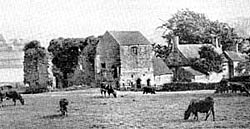< Previous | Contents | Next >
Beauvale Abbey
 |
"PULCHRA VALLIS in Parco Greselye" is what this delightful vale was called in bygone days, and Nottingham people ought to be more interested in Beauvale than they are, for not only is the neighbourhood delightful, particularly in the spring, but the ruins there to be seen are all that remain of one of the eight "Charterhouses" or Carthusian monasteries, which were all that existed in England at the time of the Dissolution of the monasteries by Henry VIII.
The Carthusians were a strange order of monks, whose zeal led them to terrible lengths of self-mortification. The mediaeval idea was that the soul was beset by three enemies, the World, the Flesh and the Devil. The World could be conquered by secluding oneself and cutting off all intercourse with everyday affairs ; the Flesh could be conquered by fastings and penances ; and the Devil by the use of the Bible.
In order the better to follow these ideals religious-minded folk banded themselves together into communities, living a common life, and cutting themselves off from the naughty world as much as possible. So developed monasteries.
In 1086 a community was established by St. Bruno at Grande Chartreuse in France, whose rule of life was so dreadfully severe that very few people could undertake it. The food and the clothing of these Carthusians as they were called, was scanty and disgusting. They spent their time in silence and in solitude, shut in their little cells, and only meeting at rare intervals for a common service and never speaking to each other.
Somewhere about 1270, Nicholas de Cantalupe married Eustachia sister and heiress of Hugh Fitz Ralph, and she brought to he; husband certain lands, so that he became the lord of Greasley, and that is how the Cantalupes came into this part of the world.
The grandson of this couple, another Nicholas Cantalupe, decided to establish a Carthusian Monastery, and accordingly on 9 December 1343, an archbishop, three bishops, three earls, three knights and a large assembly were present at the dedication of this monastery, which was placed under the protection of God and the Holy Trinity, and its inmates were charged to pray for "the welfare of the King, the repose of the souls of the father and mother of the founder, for the soul of his first wife, Typhonia, and for him and his present wife, Joan."
And so the weary, austere life of the Carthusians of Beauvale commenced. In 1540 Prior Thomas Woodcock surrendered the monastery into the hands of Henry VIII’s commissioners.
In 1908 the late Mr. Harry Gill and the Rev. A. Du Boulay Hill carried out extensive excavations on the site. The main features of Beauvale Priory have been identified and the story of the buildings is quite clear to antiquaries.
To the general public the picturesqueness of the ruins and the beauty of the setting, should be a very great attraction.
